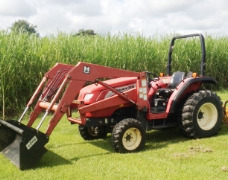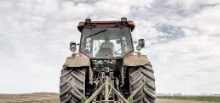________________________________________________________________________________________
| Home / Farm Tractors / Mahindra Tractors / Mahindra 3510 |
Mahindra 3510 Troubleshooting
 The
Mahindra 3510 compact utility tractor was manufactured by TYM built between 2002
and 2009. The Mahindra 3510 tractor is powered by Daedong 3A165LW 3-cylinder
indirect injection naturally aspirated diesel engine. A 101.1 cubic inches (1.7
L) engine has a cylinder bore of 3.43" (87 mm), piston stroke of 3.65" (92 mm),
and rated power of 34 hp (25.4 kW). The Mahindra 3510 is fitted with a 2
transmission options: 12x12 synchro shuttle transmission, or three-range
hydrostatic transmission.
The
Mahindra 3510 compact utility tractor was manufactured by TYM built between 2002
and 2009. The Mahindra 3510 tractor is powered by Daedong 3A165LW 3-cylinder
indirect injection naturally aspirated diesel engine. A 101.1 cubic inches (1.7
L) engine has a cylinder bore of 3.43" (87 mm), piston stroke of 3.65" (92 mm),
and rated power of 34 hp (25.4 kW). The Mahindra 3510 is fitted with a 2
transmission options: 12x12 synchro shuttle transmission, or three-range
hydrostatic transmission.
The maximum forward speed - 15.3 mph (24.5 km/h), maximum reverse speed - 14.4 mph (23 km/h). The open center hydraulic system includes a gear pump with rated fluid flow of 7.9 gal/min (30 l/min). The tractor is equipped with a hydrostatic power steering system, wet disc brakes, 27x8.50-15 or 28x8.5-15 front tyres, and 43x16-20 or 43x14-20 rear tyres. The tractor is compatible with Mahindra ML108 front end-loader with a max lift height of 87.2" (2210 mm), or Mahindra ML112 front end-loader with a max lift height of 109.6" (2780 mm).
| Diesel Engine Troubleshooting |
| Engine difficult to start or won't start |
There is air in the fuel system - Bleed the system.
Fuel filter element is clogged - Filter maintenance required.
Fuel injection nozzles are damaged - Check and replace nozzles if required.
Dirt or water in fuel system - Drain water or flush dirt from the system.
Improper valve clearance - Adjust to proper valve clearance.
Fuel injection pump malfunctioning - Repair or replace injection pump.
| Diesel starts and then shuts off |
Clogged air cleaner - Air filter maintenance required.
Fuel filter element is clogged - Change the filter element.
Fuel injection pump is leaking - Repair any leaks.
Fuel injectors are faulty or clogged - Change or clean fuel injectors.
Damaged fuel injection pump - Repair or install a new fuel pump.
| Engine stalls during operation |
Engine is not warmed up to the required temperature - Warm up engine as required.
Fuel filter plugging - Replace filter element.
Air in fuel tank - Bleed fuel tank.
Clogged or defective injection nozzles - Check injection nozzles and replace if required.
Improper setting of fuel injection pump timing - Set up as recommended.
| Engine stops at low idle speed |
Too low idle RPM - Adjust low idling as recommended.
Fuel injection pump is broken - Install a new fuel pump or repair.
Damaged or clogged injectors - Change or clean fuel injectors.
Valve clearance is not correct - Adjustment procedure required.
| Diesel power loss |
Clogged air filter element - Replace air filter element.
Fuel injection nozzles are faulty or clogged - Service or change injection nozzles.
Incorrect fuel injection pressure - Correct the pressure settings.
Valve clearance is not correct - Adjust valve clearance.
Incorrectly adjusted low idle speed - Need to adjust idle speed.
Restricted fuel lines or hoses - Clean fuel hoses and lines.
Worn cylinder head gasket - Install a new gasket.
Worn or damaged piston rings - Piston rings replacement required.
| Engine is overheated |
Insufficient coolant - Fill radiator to proper level and check components for faults.
Low engine oil level - Check oil level and add oil as required.
Faulty radiator cap or dirty radiator fins - Change cap or clean radiator.
Fan belt is loose or defective - The fan belt needs to be replaced.
Engine overload - Reduce the load or use a lower gear.
| Oil pressure is low |
Oil level is low - Fill up the engine oil.
Clogged oil filter element - Service or replace engine oil filter.
Incorrect engine oil Fill up with the correct oil viscosity.
Crankshaft bearing oil clearance is excessive - Bearing needs to be changed.
Oil pump failure - Repair or replace.
| Abnormal engine knocking or noise |
Engine oil insufficient - Check and refill engine oil.
Coolant temperature is low - Warm up engine as required.
Improper fuel injection timing - Use the correct fuel injection pump timing adjustment.
Low idle speed setting is not correct - Adjust as required.
Damaged or clogged injectors - Change or clean fuel injectors.
Misaligned or faulty connecting rod - Connecting rod needs to be aligned or changed.
Pistons are worn or broken - Pistons replacement required.
| Transmission Troubleshooting |
| Low transmission fluid pressure |
Low oil level - Need to add transmission oil.
Clogged transmission oil filter element (if fitted) - Clean or change transmission oil filter.
Relief valve failure - Replace valve as required.
| Transmission makes noise |
Insufficient transmission oil - Check and refill the transmission oil.
Transmission fluid is dirty - Change the fluid.
Incorrect backlash or gears are worn - Change worn gears or adjust backlash correctly.
Worn or cracked bearings - Faulty bearings should be replaced.
Worn or bent shift forks - Change the shift forks.
Stuck or worn shaft splines - Replace the shaft.
| Difficult to shift gears |
Corroded or worn gear shift linkage - Replace or lubricate the shift linkage.
Shift forks are worn or bent - Change defective shift forks.
Gear shifting mechanism is defective - Defective parts must be replaced.
Worn or unadjusted clutch - Clutch adjustment or replacement required.
| Transmission oil leaks |
High transmission fluid level - Drain the excess fluid.
Seals or gaskets are worn - Install new seal or gaskets.
| Hydrostatic Transmission Troubleshooting |
| Hydrostatic transmission noises |
Transmission oil is contaminated or oil level is insufficient - Add oil to proper level or pour fresh transmission oil.
Bent or unadjusted speed control pedal linkage - Adjust or repair linkage.
Relief valve failure - Replace valve as required.
Transmission is under excessive load - The load should be reduced.
Defective or worn transmission parts - After disassembly and inspection, replace defective components.
| Power is insufficient |
Insufficient transmission oil - Check and refill the transmission oil.
Defective relief valve - Replace valve as required.
Worn or unadjusted speed control linkage - Adjust or repair linkage.
| Transmission oil overheated |
Low oil level - Fill the transmission housing to proper oil level.
Transmission oil filter is dirty - Clean or change transmission oil filter.
Damaged or clogged cooling components - Inspect all cooling components and service or replace if necessary.
Transmission overloaded - The load should be reduced.
| External oil leaks |
Damaged gaskets or seals - Install new components.
High internal transmission case pressure - Change defective components.
Clogged transmission fluid return tube - Clean or replace return tube.
| Hydraulics Troubleshooting |
| Low hydraulic fluid pressure |
Low hydraulic oil level - Fill the system to proper hydraulic oil level.
Clogged hydraulic oil filter element - Replace filter element or clean if required.
Hydraulic pump failure - Repair or replace hydraulic oil pump.
Hydraulic control valve block is out of adjustment - Control valve needs to be adjusted.
Hydraulic cylinder failure - Change or repair hydraulic cylinder.
Leaks in hydraulic lines - Inspect hydraulic system for leaks and repair it.
| Hydraulic system overheating |
Main relief valve malfunctioning - Install a new relief valve.
Hydraulic oil type is incorrect - Pour the correct type of oil.
Hydraulic fluid contamination - Change hydraulic fluid.
Air in the hydraulic system - Air bleeding.
| Hitch not lifting or hitch lifts slowly |
Excessive loading on the hitch - Reduce loading.
Hydraulic oil is insufficient - Fill the system to proper hydraulic oil level.
Hydraulic fluid filter element is clogged - Hydraulic filter maintenance required.
Hydraulic pump is faulty - Install a new hydraulic fluid pump.
Main relief valve is defective - Replace relief valve.
Faulty hydraulic spool valve - Change or repair hydraulic valve.
Hydraulic cylinder is broken - Change or repair hydraulic cylinder.
Disconnected or broken suction line - Change or connect properly.
| Hitch not lowering or hitch lowers slowly |
Not adjusted hydraulic control valve - Need to adjust.
Hydraulic cylinder is broken - Install a new hydraulic cylinder or repair it.
The three-point hitch is not adjusted - The hitch must be adjusted.
Hitch cross shaft is worn - Change the shaft.
| Hitch lowering or lifting is jerky |
Air in the hydraulic system - Air bleeding.
Dirty hydraulic fluid - The fluid must be changed.
Damaged hydraulic pump - Replace or repair hydraulic fluid pump.
Hydraulic spool valve is damaged - Change or repair hydraulic valve.
Broken hydraulic cylinder - Change or repair hydraulic cylinder.
| Steering System Troubleshooting |
| Steering wheel is difficult to turn |
Damaged or incorrectly assembled steering column - Replace steering column or assemble correctly.
Air lock in the steering system - Need to bleed air.
Improper toe-in - Check toe-in and correct.
Tire pressure uneven - Inflate the tires correctly.
Hydraulic steering pump is defective - Repair or change steering pump.
Steering pump control valve is stuck or faulty - Clean or replace control valve.
Steering fluid insufficient - Check and refill steering fluid.
| Excessive steering wheel free play |
Worn steering column shaft or coupling - Change faulty part.
Steering pump not working - Install a new steering pump.
Loose or worn steering linkage components - Check and replace as required.
| Front wheels wander to right or left |
Uneven wear on front tires - Replace the tires.
Incorrect toe-in - Adjust toe-in wheels.
Steering linkage assembly is worn or loose - Check and change as required.
Worn or incorrectly adjusted or worn front wheel bearings - Adjust correctly or install new bearings.
| Electrical System Troubleshooting |
| Battery cannot be charged |
Corroded or loose wire connections - Service or tighten connections.
Faulty electrical terminal connectors - Terminal connectors should be replaced.
Battery dead cell - Change the battery.
Belt is worn or loose - Adjust belt tension or install a new belt.
| Starter turning slow |
Low battery output voltage - Charge the battery.
Battery will not hold charge - Service battery or change it.
Terminals are faulty or battery cables are disconnected - Connect wires properly or change terminals.
| Starter doesn't crank |
Battery is drained or defective - Charge or replace the battery.
Disconnected or incorrectly connected wires - Inspect battery wires and connect correctly.
Battery power is low - Charge the battery.
Starter motor is damaged - Starter needs to be replaced.
________________________________________________________________________________________
________________________________________________________________________________________
| Farm Tractors Technical Specifications |
